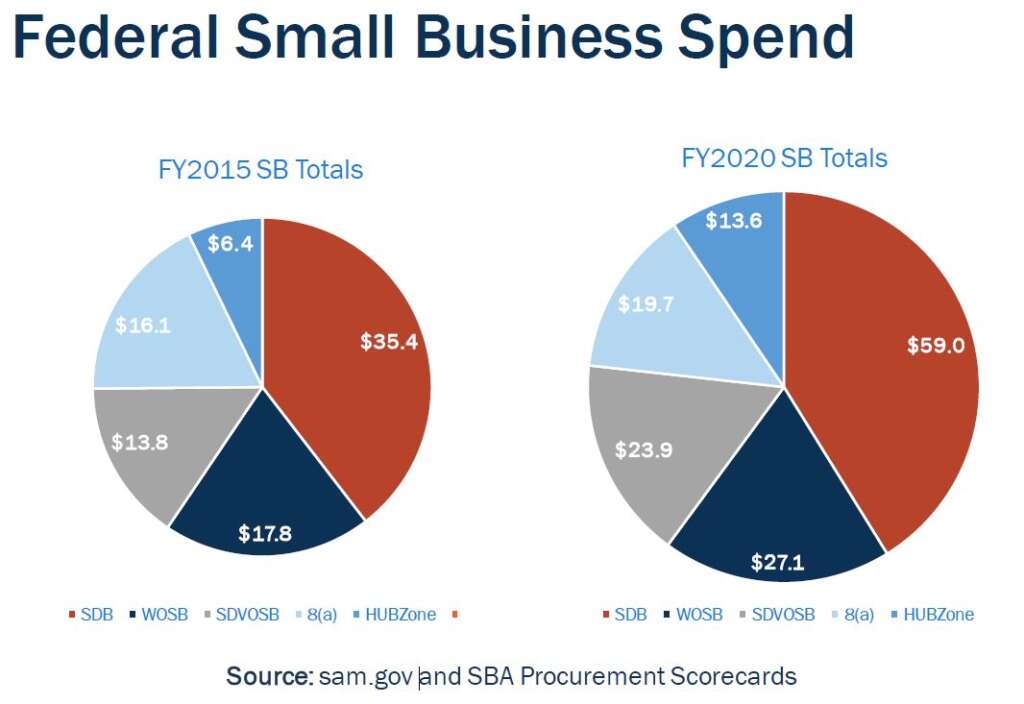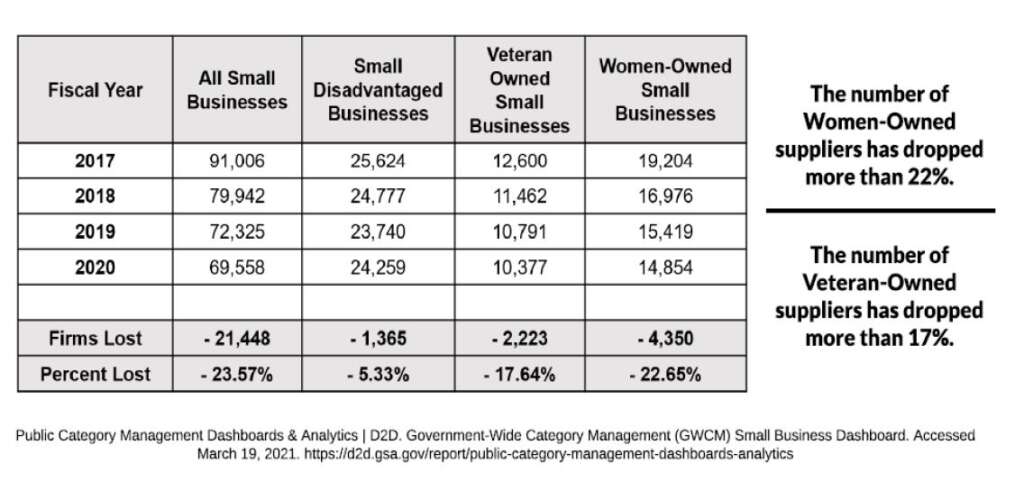Changes to make federal procurement more equitable missing key ingredients
The White House plans a series of reforms to increase contracting with small and disadvantaged businesses, including raising governmentwide goals and changing c...
The state of small business contracting in the federal government is, for lack of a better word, strange.
On one hand, more contracts and money are flowing to small and disadvantaged firms than ever before. In 2020, agencies spent more than $145 billion on contracts to small businesses. That’s more than 26% of all federal contracting spending, and exceeds a small business contracting goal of 23%. Many experts expect 2021 data, when released, to continue to show increases in overall dollars.
Since 2015, contract dollars to socioeconomic categories like small disadvantaged businesses, 8(a) firms, women-owned firms, service-disabled veteran-owned small businesses and Historically Underutilized Business Zone (HUBZone) companies also have increased across the board.

Add to that the Biden administration’s new reforms to the federal procurement process that would increase the governmentwide goal for awarding contracts to SDBs to 11% in 2022 and to 15% by 2025, and changes to category management and more accountability among agency leaders, it seems like a great time to be a small business contractor.
But then if you take a closer look at the numbers and hear from small businesses who are involved in the day-to-day of government contracting, the environment isn’t so great.
The National Contract Management Association said according to the U.S. Women’s Chamber of Commerce, there are more than 21,700 fewer small business contractors in the federal market today than in 2017. Each of the socioeconomic categories also took hits over the last four years, with the number of women-owned small firms experiencing the largest decline — both in total numbers and by percentage.

To be fair, some of that decline can be attributed to the active mergers and acquisitions market for federal contractors, especially those small firms with innovative technologies. Jennifer Schaus and Associates found that there have been 210 mergers and acquisitions in the federal market in 2021, up from 133 in 2020 and 77 in 2016. While many of these are small firms, this activity surely impacted the number of small firms.
Putting the mergers and acquisitions statistics aside, small businesses also are finding it harder to get in front of their customers.
One executive at a small contractor, who requested anonymity, said getting in front of federal acquisition and program managers is harder than ever because of the pandemic. The executive said federal executives are less likely to answer the phone, return calls or emails and virtual industry days aren’t as valuable as in-person events.
And while this is one anecdotal experience of a small business, it’s clear the business environment is tougher for firms to establish new relationships. The 2020 contractor survey from Deltek, a market research firm, found 63% of respondents said the pandemic made it more challenging to coordinate with clients, while small firms said they, more often than other businesses, saw delays or cancellations of contracts in 2020. There is no reason to think the 2021 data will change that dramatically.
Policy, regulatory changes needed
For all of these reasons, the Biden administration’s new initiative to increase the use of small and disadvantaged businesses comes at a particularly turbulent, but opportunistic, time.
“The administration’s goal is part and parcel of a core theme of the campaign. They were very serious then about putting virtually all policy ideas through a diversity, equity and inclusion (DE&I) lens, and that’s reflected in this initiative. Their belief, and I share it, is that federal procurement should be an exemplar of diversity and equity since it is funded through public funds. So, their goal is really very clear and simple,” said Stan Soloway, a former Defense Department acquisition official and now president of Celero Strategies. “That said, while I don’t necessarily have any great silver bullets to offer as an alternative, I am not sure that at least some of the new proposals are entirely practical or will necessarily achieve the intended objective.”
Other experts ask whether the administration is only splitting the small business pie in smaller pieces rather than increasing the size of the pie.
Spending on federal procurement increased to $680 billion in 2020, up more than $120 billion since 2015, while spending on small business contracts reached $59 billion in 2020, up from $35 billion in 2015.
All of these factors make the White House’s plan to increase contracting with small disadvantaged businesses much more difficult than at first glance.
Jackie Robinson-Burnette, the CEO of SES Solutions and a former deputy associate administrator for government contracting and business development at the Small Business Administration, said agencies are making progress to improve small business contracting, particularly the Navy Department, and the departments of Interior, Homeland Security, Health and Human Services and others. But there are several obstacles that the administration and Congress still need to address.

“There are going to be a significant need for regulatory and policy changes, and we can’t ignore that. When you think about the small business goals, they are goals, they are not requirements. The accountability is not there because it’s a goal and not a requirement. We will need to look at the opportunity to set-aside for 8(a)s. You can set-aside for 8(a)s, but there is no agency that has an 8(a) set-aside goal. You have a goal for SDBs, but you can’t set-aside. So why do we have a SDB goal?” Robinson-Burnette said at the NCMA event. “If you think about women-owned business, HUBZone, service-disabled veteran-owned small businesses, they have goals and you can set-aside contracts. We are talking about SDBs, so it will require regulatory and policy changes to fix the disparity about why this program has a goal, but you can’t set-aside. Is this the time to fix it?”
She added when she worked at SBA, some agencies said they were not putting new opportunities in the 8(a) program because SBA was slow in getting the program participant applications processed and the pool of potential bidders is shrinking or not as qualified.
Another one of those challenges the administration needs to consider is how to grow the industrial base. Soloway said a focus on subcontractors initially to build the prime base may be one approach that the White House should consider.
“There is a huge amount of money (far more in fact) that goes out in subcontracts. How do we capitalize on THAT spend to ensure more of it goes to high value, higher mobility work? And what about location of prime or sub work (regardless of company ownership)?” he said. “If we want to utilize the massive federal spend to help address the evident wealth and income gaps, looking at those questions–quality of work and locationhave to be included. Similarly, there is relatively new data from SBA which shows that a sizeable percentage of the growth in 8(a) contracting in recent years has gone to Alaskan Native Corporations (ANCs).”
Robinson-Burnette said another option would be to add to a contract’s evaluation factor how the prime will partner with SDBs. The Defense Department currently uses small business participation as an evaluation factor and she said expanding this across the government would provide incentive to both companies and agencies.
The White House is attempting to bring in more incentives, including making small business contracting a part of a manager’s performance review and letting agencies take credit for SDB contracting under category management.
Soloway, however, said the goal of holding managers accountable is laudable, it can’t be more important than ensuring agencies are meeting mission goals.
“It’s true that the best way to drive change is to incentivize and reward it, but given the nature and rules around General Schedule employees (and to a large extent, the SES as well), how does that work? There are substantial built-in limitations on how financial incentives can be used. As a result, I just don’t understand how this will work. Seems to me the way to make it happen is to hold leadership accountable in some way,” he said. “Also, as important as diversity and equity are, the entire Federal Acquisition Regulation is structured around finding the outcome that is in the best interests of the government and taxpayer. One can certainly make the argument that DE&I are very much in the interest of the government and taxpayer, but to what extent does it trump other award factors—performance history, cost?”
Growing the industrial base
Even with all of the White House’s initiatives, agencies still may have trouble finding enough qualified small business prime contractors. Growing the industrial base, specifically in the socio-economic areas, is a critical piece the administration hasn’t addressed directly.
The private sector is trying to step into that gap. Richard Hanks, the chief operating officer of MMC Consulting, said at the NCMA event that he’s leading a new effort called FedPropel to help increase the number of SDB firms in the industrial base.
Hanks said the goal of the program is to train 3,000 SDBs by 2030.
“It’s a federal contracting accelerator for SDBs. The idea being, it’s one thing to get a contract, but it’s a whole other thing to execute that contract properly. Most small businesses step into the market just wanting to get a contract, but is that really what you are looking to do? If you want to be here 5, 6, 10 years down the line and grow your business into the next CACI, Leidos or what have you, you need a plan of action. Your business process support systems have to be in place, and you will not step out the door in six months and say ‘I need a $10 million contract because I’m so wonderful.’ You have to build your presence in the marketplace. You have to understand the FAR, the DFAR, CMMC and you have to be able to team and partner. And then once you’ve established yourself and created a platform that allows you to work within the marketplace, then you can go after the $5 million or $10 million contract — and then you can put yourself in a position to be successful in the long term.”
Hanks added that FedPropel’s goal is similar to the Biden administration’s, which is to make federal procurement more reflective of country.
Like we’ve seen in the past, small businesses get the best lip service. The question is how will the Biden administration change what history has shown us — small business contracting is a nice talking point, but it loses out on the priority list.
Copyright © 2024 Federal News Network. All rights reserved. This website is not intended for users located within the European Economic Area.
Jason Miller is executive editor of Federal News Network and directs news coverage on the people, policy and programs of the federal government.
Follow @jmillerWFED






